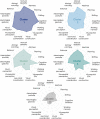Cognitive, perceptual, and motor profiles of school-aged children with developmental coordination disorder
- PMID: 35992485
- PMCID: PMC9381813
- DOI: 10.3389/fpsyg.2022.860766
Cognitive, perceptual, and motor profiles of school-aged children with developmental coordination disorder
Abstract
Developmental coordination disorder (DCD) is a heterogeneous condition. Besides motor impairments, children with DCD often exhibit poor visual perceptual skills and executive functions. This study aimed to characterize the motor, perceptual, and cognitive profiles of children with DCD at the group level and in terms of subtypes. A total of 50 children with DCD and 31 typically developing (TD) peers (7-11 years old) underwent a comprehensive neuropsychological (15 tests) and motor (three subscales of the Movement Assessment Battery for Children-2) assessment. The percentage of children with DCD showing impairments in each measurement was first described. Hierarchical agglomerative and K-means iterative partitioning clustering analyses were then performed to distinguish the subtypes present among the complete sample of children (DCD and TD) in a data-driven way. Moderate to large percentages of children with DCD showed impaired executive functions (92%) and praxis (meaningless gestures and postures, 68%), as well as attentional (52%), visual perceptual (46%), and visuomotor (36%) skills. Clustering analyses identified five subtypes, four of them mainly consisting of children with DCD and one of TD children. These subtypes were characterized by: (i) generalized impairments (8 children with DCD), (ii) impaired manual dexterity, poor balance (static/dynamic), planning, and alertness (15 DCD and 1 TD child), (iii) impaired manual dexterity, cognitive inhibition, and poor visual perception (11 children with DCD), (iv) impaired manual dexterity and cognitive inhibition (15 DCD and 5 TD children), and (v) no impairment (25 TD and 1 child with DCD). Besides subtle differences, the motor and praxis measures did not enable to discriminate between the four subtypes of children with DCD. The subtypes were, however, characterized by distinct perceptual or cognitive impairments. These results highlight the importance of assessing exhaustively the perceptual and cognitive skills of children with DCD.
Keywords: Developmental coordination disorder; cluster analysis; executive functions; subtypes; visual perceptual skills.
Copyright © 2022 Van Dyck, Baijot, Aeby, De Tiège and Deconinck.
Conflict of interest statement
The authors declare that the research was conducted in the absence of any commercial or financial relationships that could be construed as a potential conflict of interest.
Figures

Similar articles
-
Motor impairments screened by the movement assessment battery for children-2 are related to the visual-perceptual deficits in children with developmental coordination disorder.Res Dev Disabil. 2014 Sep;35(9):2172-9. doi: 10.1016/j.ridd.2014.05.009. Epub 2014 Jun 7. Res Dev Disabil. 2014. PMID: 24915646
-
Nature and Specificity of Gestural Disorder in Children with Developmental Coordination Disorder: A Multiple Case Study.Front Psychol. 2017 Jul 4;8:995. doi: 10.3389/fpsyg.2017.00995. eCollection 2017. Front Psychol. 2017. PMID: 28725201 Free PMC article.
-
Nature of motor impairments in autism spectrum disorder: A comparison with developmental coordination disorder.J Clin Exp Neuropsychol. 2019 Feb;41(1):1-14. doi: 10.1080/13803395.2018.1483486. Epub 2018 Jun 20. J Clin Exp Neuropsychol. 2019. PMID: 29923455
-
Developmental coordination disorders: state of art.Neurophysiol Clin. 2014 Jan;44(1):13-23. doi: 10.1016/j.neucli.2013.10.133. Epub 2013 Oct 31. Neurophysiol Clin. 2014. PMID: 24502901 Review.
-
Motor Skills and Visual Deficits in Developmental Coordination Disorder: A Narrative Review.J Clin Med. 2022 Dec 15;11(24):7447. doi: 10.3390/jcm11247447. J Clin Med. 2022. PMID: 36556062 Free PMC article. Review.
Cited by
-
Use of Virtual Reality in School-Aged Children with Developmental Coordination Disorder: A Novel Approach.Sensors (Basel). 2024 Aug 28;24(17):5578. doi: 10.3390/s24175578. Sensors (Basel). 2024. PMID: 39275489 Free PMC article.
-
Children with developmental coordination disorders: a review of approaches to assessment and intervention.Front Neurol. 2024 May 23;15:1359955. doi: 10.3389/fneur.2024.1359955. eCollection 2024. Front Neurol. 2024. PMID: 38846037 Free PMC article. Review.
-
Body-Related Visual Biasing Affects Accuracy of Reaching.Brain Sci. 2024 Dec 17;14(12):1270. doi: 10.3390/brainsci14121270. Brain Sci. 2024. PMID: 39766469 Free PMC article.
-
Association between Motor Skills, Occupational Performance, and Mental Health in Japanese Children with Neurodevelopmental Disorders: A Cross-Sectional Correlational Study.Children (Basel). 2024 Jul 26;11(8):899. doi: 10.3390/children11080899. Children (Basel). 2024. PMID: 39201834 Free PMC article.
-
Which outcomes are key to the pre-intervention assessment profile of a child with developmental coordination disorder? A systematic review and meta-analysis.Biomed J. 2025 Apr;48(2):100768. doi: 10.1016/j.bj.2024.100768. Epub 2024 Jul 18. Biomed J. 2025. PMID: 39032866 Free PMC article.
References
-
- Allen D. N., Goldstein G. (eds) (2013). Cluster Analysis in Neuropsychological Research. New York, NY: Springer. 10.1007/978-1-4614-6744-1 - DOI
-
- American Psychiatric Association [APA] (ed.) (2013). Diagnostic and Statistical Manual of Mental Disorders: DSM-5, 5. Edn. Washington, DC: American Psychiatric Publishing.
LinkOut - more resources
Full Text Sources

